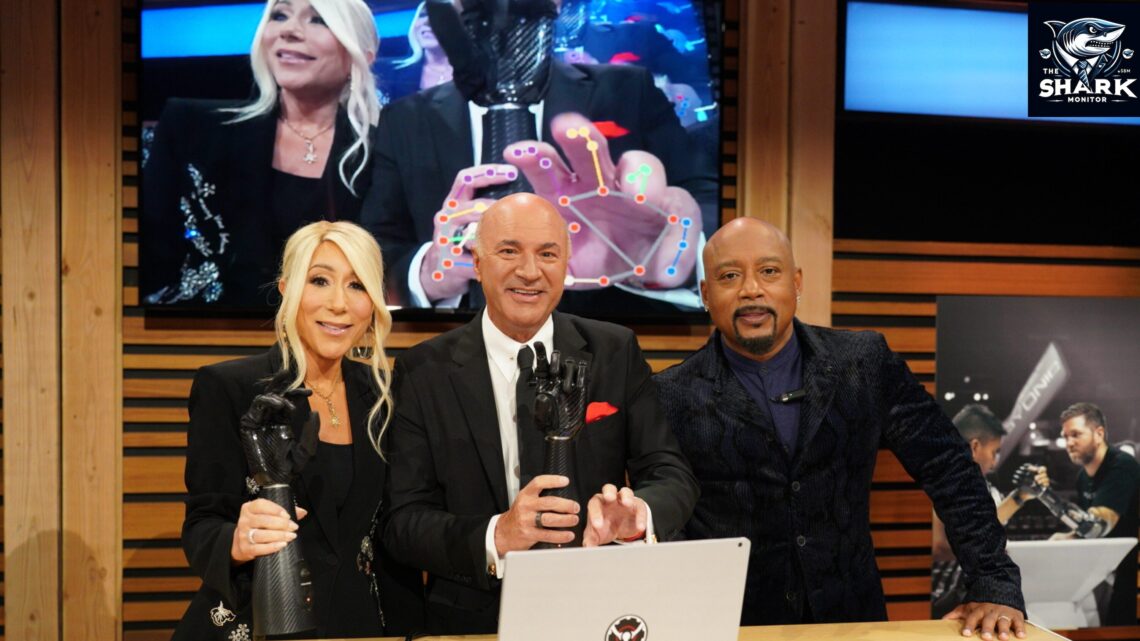
PSYONIC Shark Tank: In-Depth Analysis of a Life-Changing Bionic Hand
The Psyonic Shark Tank pitch was a one-of-a-kind. Psyonic’s product is a robotic hand for amputees, registered with the Food and Drug Administration (FDA), covered by Medicare, and allows amputees to receive touch signals from the robotic fingers. Given all of this (and more), the $1,000,000 ask doesn’t seem absurd at all, relative to the potential impact on quality of life. But let’s see what happened.
Psyonic – Investment Summary:
- Amount and equity asked: $1,000,000 for 2% equity
- Amount and equity received: $1,000,000 for 6% equity
- Shark(s) in the deal: Daymond John, Lori Greiner, Kevin O’Leary
- Valuation of the deal: $16,666,666
Table of Content:
Psyonic Shark Tank Pitch
Dr. Aadeel Akhtar walked down the entrance of Shark Tank in episode 15 of Season 15.
Carrying a bionic hand, he started with:
Hi Sharks. I’m Dr. Aadadel Akhtar from San Diego, California. I’m here seeking $1 million for 2% equity in my company: Psyonic, where we develop advanced bionic limbs that are accessible for both humans and robots.
Aadeel Akhtar – Shark Tank
First, that is probably one of the highest valuations in Shark Tank history: $50,000,000!
Starting with a story of when he was seven years old, he developed the Ability Hand. It is the fastest bionic hand on the market, and the first one to offer touch feedback to users, and you can control it with your muscles.
Aadeel continues talking about a few more features of the bionic hand, such as being USB rechargeable, waterproof
Fun fact:
Aadeel mentioned that you can recharge your phone from your hand…that’s quite superhuman!!
The Touchy Moment of Psyonic’s Pitch
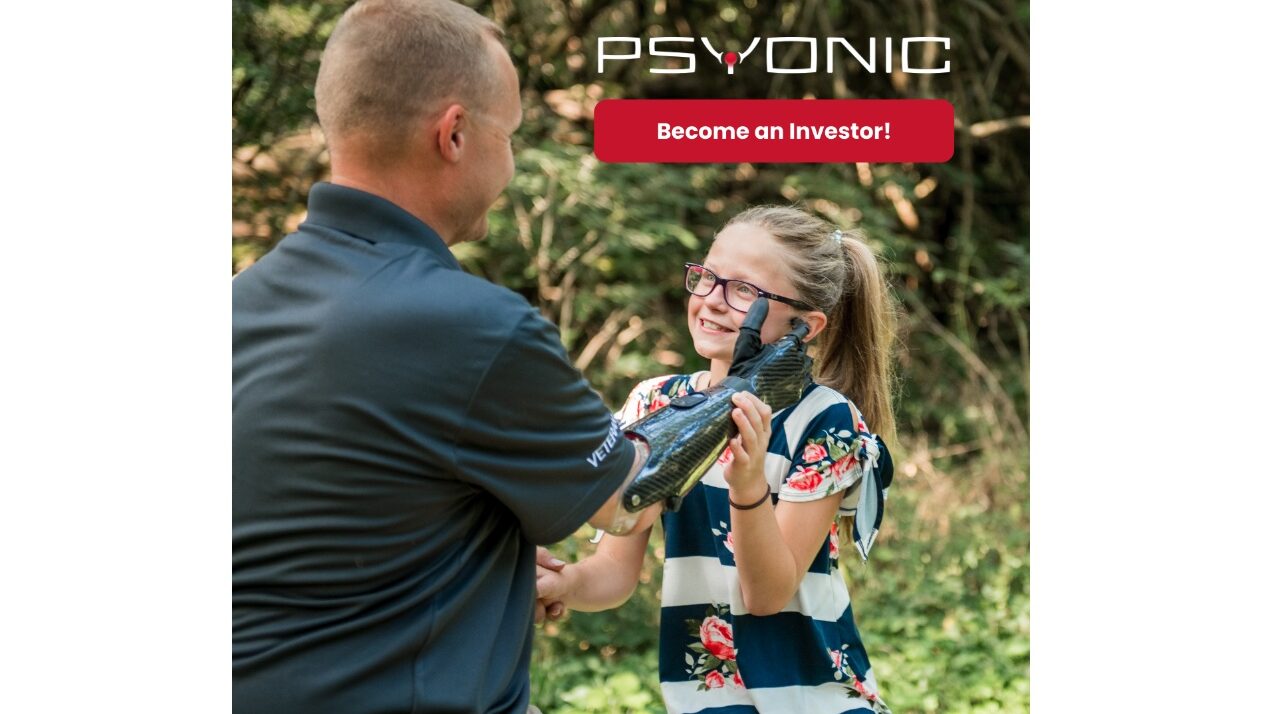
When I was listening to Aadeel’s presentation, he said that Sergeant Anderson was able to hold and feel his daughter’s hand again!!
Now…I have a four-year-old daughter, she’s my life, and God bless me, I can hold her hand every day. When Aadeel said that, I almost got teary eyes. There is nothing more important, and more heartfelt, than holding your little one’s hand. I can’t even explain how that single sentence made me very empathetic towards Sgt. Anderson.
Anyhow, enough about how I feel. Let’s go back to Psyonic Shark Tank pitch.
While Sgt. Anderson can walk while holding the soft hand of his daughter, he can also use the bionic hand to kick ass! Aadeel shows Sgt. Anderson breaking a 2-inch wood plank like a real Karate master! Needless to say, this wowed the Shark to a whole new level.
Lastly, on top of giving superhuman abilities to amputees, the Ability Hand is also used in robotics, and even in space.
Psyonic Previous Investments
To date, or at least up to the show, Aadeel raised a total of $3.6 million. They are divided as $1.4 at a $12M valuation and $2.2 million on a Start Engine campaign at a $50 million valuation. They also have funds from grant agencies. Aadeel holds a $2.4 million grant and has another one pending for $2.7 million from the DOD.
After hearing these numbers, Mark Cuban is curious why Aadeel spent so much time raising only $2.2 million on Start Engine, when, given the features of his product, tons of people that would write that check. Aadeel has a great, surprising reason: most of their sales come from social media!
Psyonic Costs and Sales
The hand costs $15,500 and costs $1,800 to make it. As of March 2024, Psyonic had over 100 patients using their bionic hand, and a lifetime sales of around $2,000,000. The previous year’s sales were at $1,000,000 with a net profit of $100,000. This year the projected sales are at around $2,000,000.
While the number of sales is not as high as one would expect, Aadeel’s production pipeline is running at capacity with about 100 Ability Hand produced each year. By ramping up production, he’s hoping to scale to 500 a year, then 1k, and so on.
Mark asked why the Veterans Affairs (VA) was not all over him. Aadeel replied that the VA is all over him, and they gave to the VA all they can produce, and that’s why they need an investment to ramp up production. To reach 1,000 units per year, Aadeel would need around $5 million at this round.
Robert jumped in asking why he didn’t go to an “equity guy”, aka venture capital, that specializes in robotics and healthcare. Here Aadeel responded with the issue that equity people focus either 100% on robotics or 100% on healthcare. Thus, finding that translational bridge has been a challenge.
Psyonic Negotiation and Outcome
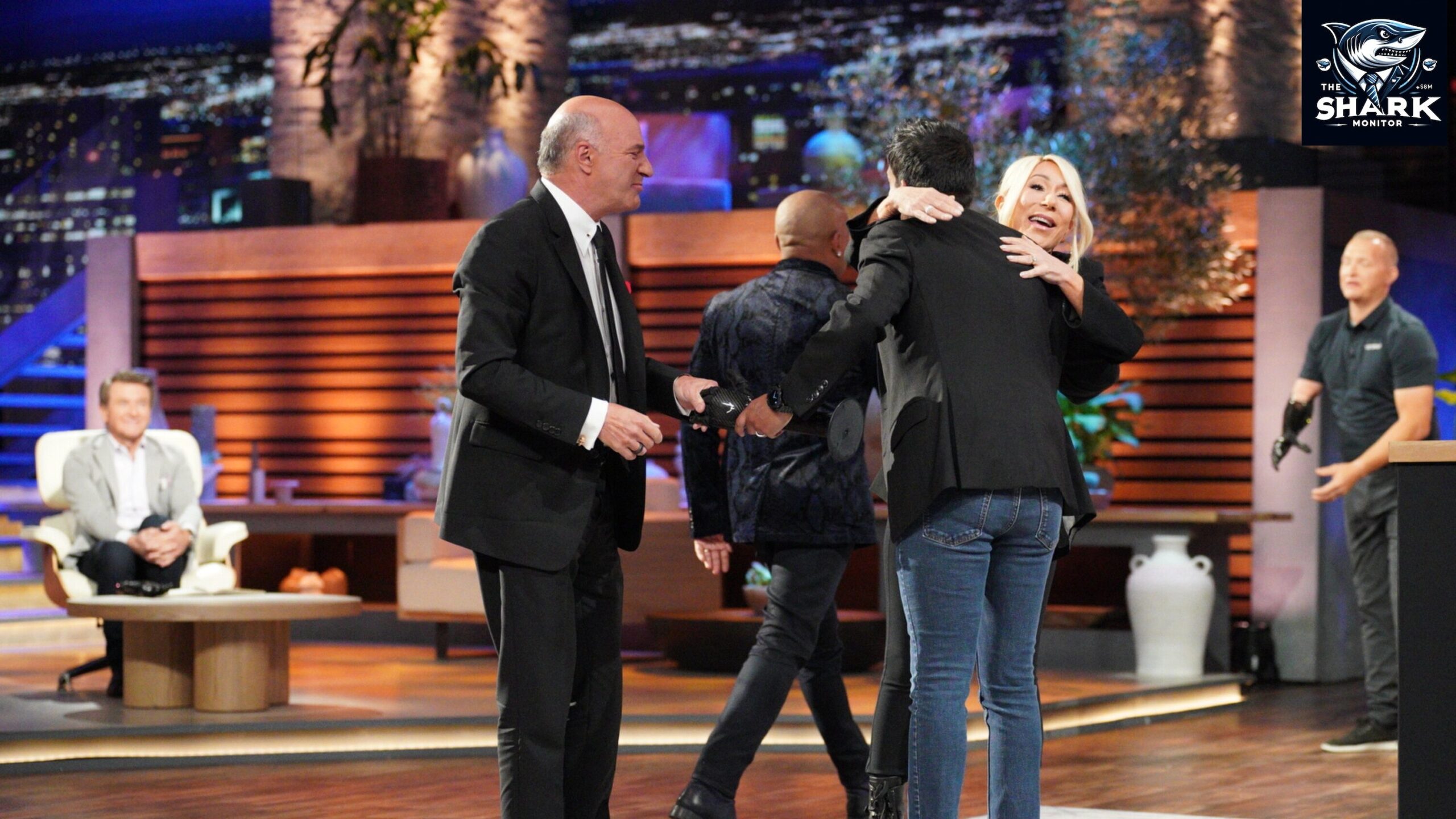
Mark is not fully convinced that investors weren’t sold into offering $5 million, or similar, after learning how Psyonic could change lives. Because of this skepticism, he was out.
Robert described his experience of seeing a friend at Dancing with the Stars, Noah Galloway, who lost his arm and leg while in the military. Robert became aware of the issues faced by amputees, including pain and infections. Moreover, here’s where Aadeel mentioned that Psyonic produces just the hand, not the whole attachment. Now, since Robert is aware of all of these challenges, he is still too skeptical. And with that, he’s out.
Kevin quickly reviewed the numbers, but he’s worried about the 2% equity because the more Psyonic grows, the more investments it needs, and the more investments, Kevin’s equities become more diluted. For that, Kevin offers 10% for $1 million, but Aadeel politely refuses.
Lori and Daymond go straight to the point and make an offer to Aadeel. The offer is $1,000,000 for 6%, and they don’t want to be diluted. Aadeel, conscious of the other investors, replies with 4% as 2% equity and 1% each in advisory shares. Lori counters with the 4%, including 2% advisory shares, but they must be non-dilutable.
In the negotiations, Daymond offers to meet Aadeel in the middle, at 5%. Kevin then jumps back in saying that he’d do the deal at 5%.
Things are getting spicy now. Aadeel asks Kevin to jump in with Lori and Daymond. Daymond proposes a 7.5% equity with 2.5% equities in common shares per Shark. Kevin, strangely, now admits that he’d do the deal for 6% equities, at 2% per each Shark.
And with that, Aadeel makes a handshake deal with Lori Greiner, Daymond John, and Kevin O’Leary for $1,000,000 for 6% equity in Psyonic.
The Mission Behind Psyonic
Even before Shark Tank, Psyonic aimed to revolutionize the experience of those in need of bionic prosthetics by integrating biotechnological advancements with the human body. Aadeel’s company works at the forefront of bionic innovation, pushing the limits of how prosthetic devices interlace with the human neuromuscular system.
One of the great goals for the upcoming decade is to achieve total integration, where devices will communicate fluidly with human nerves and muscles, enhancing life for users. Psyonic envisions a future where their prosthetics are not only functional extensions of the human body but tools that restore and extend capability.
Accessibility over Profits?
Aadeel’s mission seems to go beyond growing Psyonic to a billion-dollar business. S
The team at Psyonic believes that advanced prosthetics should not be a luxury but a readily available solution for those in need. And that is why they worked diligently to lower the barriers that have historically limited access to state-of-the-art prosthetic technology by registering the Agility Hand with the FDA, and working with Medicare.
Thus, reaching a wider audience would mean being able to help millions of amputees who struggle with everyday tasks.
Dr. Aadeel Akhtar: Psyonic Founder and CEO
Aadeel Akhtar is the driving force behind PSYONIC, a company dedicated to creating advanced, yet affordable prosthetic limbs.
His journey began as a seven-year-old in Pakistan, where he met someone missing a limb, she was a girl his age without a leg. She was living in a poor part of Pakistan, and using a tree branch as a crutch. This encounter is what inspired Aadeel to help amputees and stirred a deep sense of purpose.
Education and Training
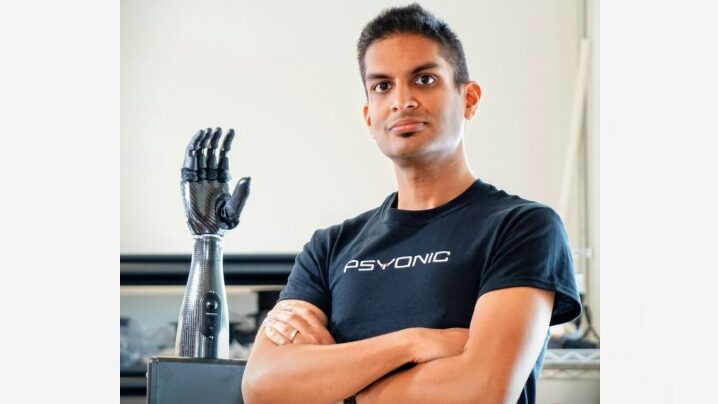
Aadeel is not shy of academic achievements. He has two M.Sc. and one doctorate (Ph.D.) in Neuroscience. Thematically, his education revolved around biology, computer science, and engineering. It appears that his current career is a balanced mix of what he studied in the past.
- Ph.D. in Neuroscience
- M.S. in Electrical & Computer Engineering
- University of Illinois at Urbana-Champaign, 2016
- B.S. in Biology, M.S. in Computer Science
- Loyola University Chicago, 2007 & 2008
Akhtar’s research focuses on enhancing motor control and sensory feedback in prosthetic devices.
Collaborating with esteemed institutions like the Center for Bionic Medicine and Northwestern University, his work is pivotal in the field of bionics.
Achievements:
- Named among MIT Technology Review’s top 35 Innovators Under 35
- Featured in Newsweek’s America’s Top 50 Disruptors
His advocacy isn’t confined to the lab. Akhtar actively engages with the O&P community, sharing his insights at key events like the 3D Printing O&P conference.
Challenges and Solutions:
PSYONIC’s mission is intertwined with manufacturing challenges and funding obstacles.
Akhtar’s tenacity turned these into opportunities, enabling PSYONIC to produce robust, water-resistant, fast, and sensitive-to-touch prosthetic hands, suitable even for humanoid robots and manufacturing arms.
For those aspiring to make an impact, Akhtar’s advice is straightforward: build and create with passion, applying theoretical knowledge to practical, real-world problems. The road less traveled often leads to groundbreaking destinations.
Breakdown of the Costs for a Psyonic Ability Hand
The Ability Hand, a state-of-the-art prosthetic, is priced at around $15,000. This cost does not include fitting, testing, or additional components. Below, the costs are broken down to help clarify the potential financial considerations for prospective users:
- Base Price: $10,000 – $20,000
- Medicare Coverage: Can cover $30,000 – $50,000
Optional Accessories (Prices Vary):
- Lamination Ring
- Electrodes
- Electrode Cables
- Wrist Rotator
- Compatible Elbow Systems
- COAPT Gen2 System
It is important to note that the wrist disarticulation model of the Ability Hand and its compatibility with 1/2”-20 bolt short wrists can affect pricing.
The hand itself is compatible with a 6-ring Motion Control Pro and Standard wrist rotators, elective additional purchases.
As in every product, individual needs will dictate the final cost, as the prosthesis can be customized with various optional components. These include an array of coupling pieces, lamination rings, electrodes, wrist rotators, and elbow systems. Such customization ensures user-specific functionality but also implies varying final costs.
Prospective users should be mindful that while Medicare can cover a substantial portion of the cost, out-of-pocket expenses may occur depending on selected options and coverage details.
How Does Psyonic Ability Hand Work?
The Psyonic Ability Hand is a state-of-the-art prosthetic hand that restores functions for individuals with limb loss. It integrates seamlessly with various prosthetic devices through a standard quick disconnect interface, for ease of use.
Battery-powered performance
This prosthetic hand operates using a PSYONIC Battery Pack, which is a robust 7.4VDC lithium polymer battery that powers the device.
The overall performance of the Ability Hand is impressive thanks to its precision and multiple grip patterns. Equipped with 32 grip patterns, 20 of which are predefined, it allows users to perform a broad range of tasks.
Users also have the freedom to adjust grip patterns and sensitivity settings through the dedicated PSYONIC App, available for Android and iOS devices.
Tactile System of the Bionic Hand
An innovative feature is the hand’s tactile feedback system. The PSYONIC Vibration Unit relays vibrational feedback to the wearer, proportionate to the grip force exerted by the hand’s fingertips. This allows users to gauge how firmly they are holding objects, to maximize control.
For enhanced maneuverability, the Ability Hand offers two wrist options: an Electronic Quick Disconnect (EQD) and a short wrist. The EQD allows 360˚ rotation and easy detachment from the socket. In contrast, the short wrist is designed for those with distal amputations, offering 90˚ of pronation and supination.
Because of the complexity of the system, users will need to consult a certified prosthetist to pair the Ability Hand with the control systems. However, the Industry Standard Quick Disconnect Interface simplifies the connection to various prostheses, while interface cables effectively transmit power and control signals.
Psyonic, The Science Behind It
Note to the reader: this section is quite technical, and it digs a bit into the science that makes the Psyonic’s bionic hand work so well. The table below is a quick summary. Read the rest at your own risk!!
| Key Idea | Simple Explanation |
|---|---|
| Skin-integrated haptic interfaces | Tiny vibrating patches on the skin provide feedback, making prosthetics feel more real; used in virtual reality too! |
| How it works | Flexible electronics stick to the skin, and wireless tech sends power & instructions |
| EMG Signals | Electrical signals from your muscles help control the prosthetic with precision |
| Skin-friendly design | Special materials make sure the electronics work well on your skin without irritation |
| Low-power tech | The vibrating parts use very little energy, so they don’t get hot |
| Software smarts | Tracking shoulder position helps predict detailed movements, making control easier |
| Adapting to you | Newer tech adjusts feedback in real-time so it always feels the same, no matter what you’re doing |
There is a lot of science behind this hand. And it is backed up by seven peer-reviewed publications, as of 2021. They revolve around various aspects of the interaction between humans and robotic components.
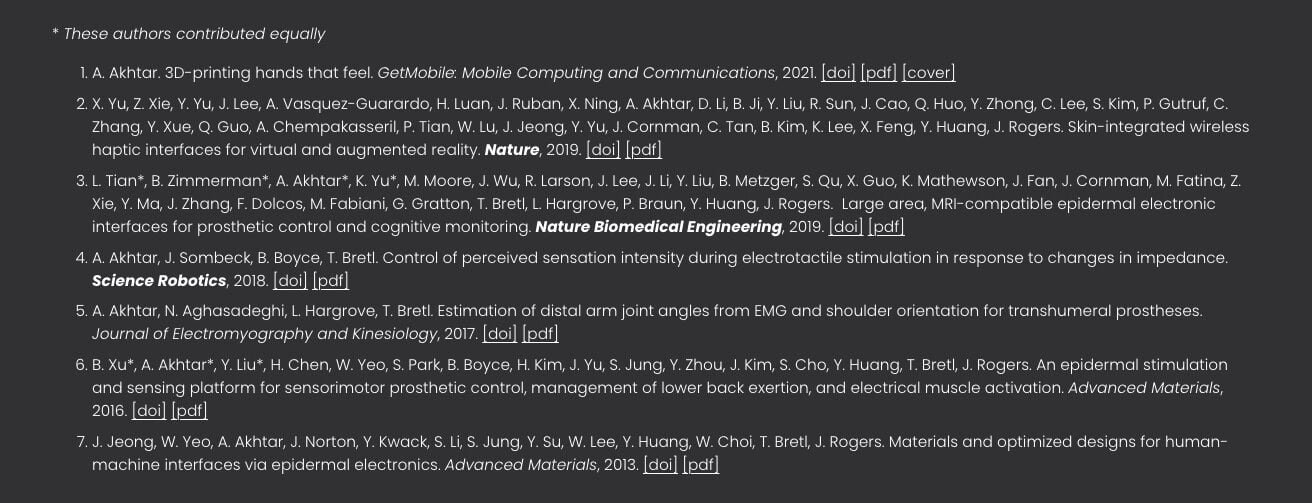
Recent advances in biomechanical engineering increased the capabilities of prosthetics sitting on the human-machine interface. One such innovation is a skin-integrated haptic interface.
These interfaces use arrays of tiny, vibratory actuators, embedded within flexible electronics, to deliver sensory feedback. These systems can stick non-invasively to the skin, and they are powered and controlled wirelessly using Near-Field Communication (NFC) protocols.
Electromyography (EMG) signals also play a key role in prosthetic control. Skin-mounted electronics capture these biological signals used to fine-tune the resolution in prosthetic manipulation.
Moreover, the mesh electrodes designed for these systems can adapt to skin ridges, maintaining signal quality without compromising skin health.
Importantly, these interfaces integrate seamlessly with the user’s sensory system. They offer an immersive experience in virtual and augmented reality applications by replicating a broad spectrum of tactile sensations.
The actuators employed require minimal power, about 1.75 mW, avoiding undesirable heating effects and maintaining consistent responsiveness at various angles and bends.
In conjunction with EMG, sophisticated software algorithms use shoulder orientation to estimate joint angles, enhancing the precision of prosthetic limb control. It’s like predicting the movement of a hand by looking at what the shoulder is doing.
This integration translates to improved accuracy and potentially reduced calibration times for users.
Ongoing research in adaptive electrotactile feedback stands to further revolutionize the field. By modulating stimulation based on real-time impedance measurements, consistent intensity of sensation can be maintained. This adaptability extends the utility of electrotactile feedback across multiple domains, from prosthetic sensation to interactive touch displays.
Psyonic Early Investments and Awards
Investments:
- In 2022, Psyonic secured a seed investment of $554K. Start Engine, a leading equity crowdfunding platform, facilitated this investment.
- Before that, the company received three consecutive years of grants labeled as prize money from America’s Seed Fund. The amounts were $225K in 2018 and 2019, and a significant $937K in 2020.
Awards:
- Psyonic has been recognized by MIT Technology Review as one of the 35 Innovators Under 35 in 2021.
- The company’s product was named the 2020 mHUB Product of the Year.
- A prestigious Social Innovator’s Cup was won by Psyonic in 2019 from 8VC with an $8K prize.
- Their innovation won the Illinois Innovation Prize for $20K in 2016.
Competitions and Prizes:
- The Forbes 30 Under 30 list in Healthcare featured Psyonic’s early achievements in 2016.
- They have also been successful in venture competitions. They won at the Cozad New Venture Competition in 2015, where they received $25K in total prize money, including the Samsung Research Innovation Prize.
- During the 2015-2016 term, Psyonic was part of the iVenture Accelerator, receiving $10K in support.
- The same period saw an award from VentureWell for their Stage I E-Team for $5K.
Psyonic Strategic Partners
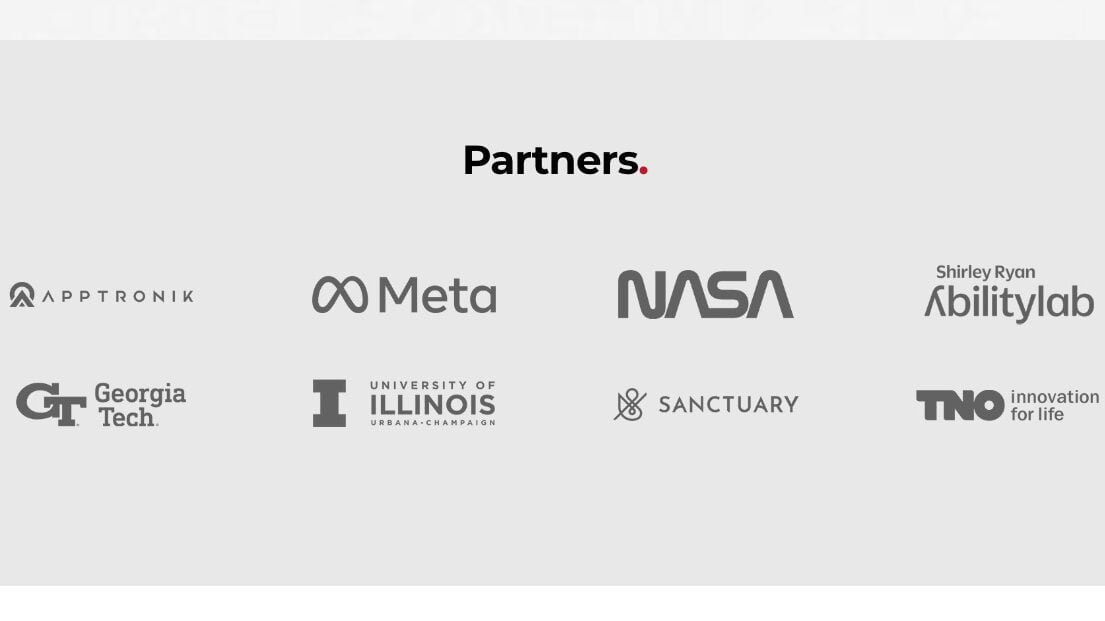
Psyonic has picked up strategic partnerships with technological giants to develop their innovative bionic hand.
A key collaboration includes working with NASA, which has shown interest in the Ability Hand™ for space exploration applications.
In the tech industry, Meta, aka Facebook and Instagram’s mother company, purchased two bionic hands. Meta’s involvement focuses on their potential use in virtual environments and human-computer interactions.
Furthermore, Psyonic’s journey from concept to market was significantly shaped by the iVenture Accelerator. This University of Illinois incubator provided crucial business guidance, helping Psyonic formulate a business plan driven by market demand and secure substantial funding.
Psyonic Patents
Aadeel was wise in submitting, and obtaining, several patents to protect Psyonic’s IP on innovative prosthetic technologies:
- A System and Method for an Artificial Tendon-Driven Prosthesis
Filed on February 11, 2021, this patent outlines a system that simulates the function of natural tendons in a prosthesis.
- Advanced Prosthetic Hand
With the filing date of September 23, 2019, this particular patent presents a sophisticated design for a prosthetic hand that aims to replicate the complex movements and capabilities of a biological hand.
- Prosthetic Hand with Sensored Brushless Motors
Filed on March 29, 2019, the patent describes a method for incorporating sensored brushless motors within a prosthetic hand, enhancing its grip and dexterity.
- Compliant Four-Bar Linkage Mechanism for a Robotic Finger
This patent, filed on April 27, 2018, details a specific mechanism within a robotic finger that grants it a more compliant and natural movement.
Psyonic Competitor Analysis
PSYONIC operates in a competitive space with numerous companies developing advanced prosthetic technology. Competitors range from startups to well-established enterprises in the field of bionics. They all have some potential life-changing products with applications to civilians and the military. Yet, each has pros and cons that may allow Psyonic to get an edge over the long run. Some competitors I could find are:
- Exobot focuses on bionic limbs and exoskeletons. They enhance mobility and support for users.
- Symbionic targets the bionic prosthesis market, specifically for limb amputees. They offer solutions to restore functionality.
- Cheke Systems specializes in providing advanced robotic prosthetic limbs.
- CortexBCI develops an EEG-based mind-controlled bionic arm. They integrate brain signals for prosthesis control.
- Paeon and Grasp Bionics both engage in the development of advanced arm prosthetics.
- Atom Limbs utilizes cloud and AI technologies to provide robotic prosthetic arms.
- Robo Bionics offers a prosthetic hand system designed to help amputees regain autonomy.
- Brink Bionics is involved in creating robotic upper-limb replacement technologies.
- Esper Bionics focuses on AI-based orthopedic prosthetic solutions along with neurology products.
- Piltover Technologies provides artificial limbs to enable disabled individuals to overcome their physical limitations.
- BLINCdev aims to enhance the natural control of bionic limbs.
- BionicM, MELTIN MMI, and Hy5 are all key players in improving movement assistance through advanced prosthetic technologies.
- Nuada creates specialized hand gloves designed to amplify grip strength for industrial and rehabilitative purposes.
- Open Bionics excels in manufacturing robotic prosthetic hands that are accessible and innovative.
- Touch Bionics has a legacy of developing upper-limb prostheses for patients with limb deficiencies.






